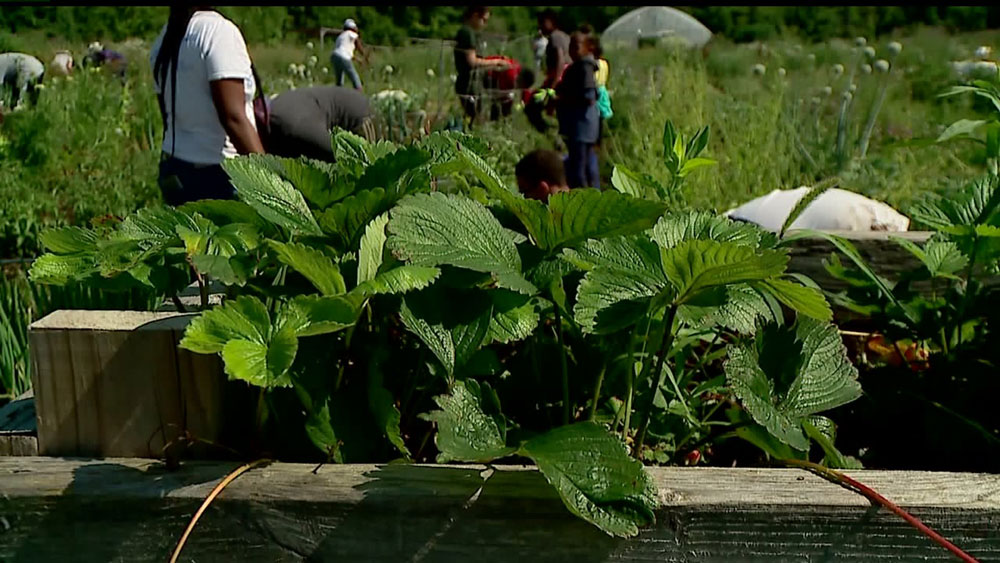
July 7, 2020; Indianapolis Star
In April, NPQ profiled urban agriculture efforts in Minnesota. In this article, we cast our gaze southward to Indiana, where Indianapolis Star reporter Sarah Bowman provides a portrait of community gardens and urban agriculture in Lawrence, a small town of just under 50,000 people, located a little more than 10 miles northeast of the state capital of Indianapolis. As was the case in the Twin Cities, we find a mix of outcomes as the need for local food in a time of hunger goes up, but, amid the pandemic, the number of volunteers declines, and raising donor funds is also a significant challenge.
One of the gardens (really, small farms) that Bowman profiles is Lawrence Community Gardens, a 7.6-acre farm that has been operating as a nonprofit since 2016. In its three seasons, Lawrence Community Gardens grew food for the Lawrence community, with at least half of the food grown on the farm donated to local food pantries and for meal services for seniors. Some of the rest of the produce is sold at a local farmer’s market and at a food stand on the farm.
Sharrona Moore is the founder and main steward of the garden. Moore notes that the pandemic has caused grocery store shortages and made visible many failings in the food system, while causing major increases in food insecurity, making the importance of community gardens and local food sources obvious.
Still, many community gardens have only been able to plant a fraction of their acreage, and Lawrence Community Gardens is among those that have had to cut back. Moore tells Bowman they were able to plant one quarter of its seven acres.
“We’re behind the curve,” Moore says, “but we’re still trying to push through.”
Typically, Moore relies on volunteers to be able to get everything planted, but that hasn’t been possible with physical distancing. “That’s a big deal for us because that’s how we get our spring crops for summer in the ground,” Moore explains.
Moore says she and the volunteers she was able to have safely assist her have been able to plant lettuce, leeks, and Swiss chard thus far, as well as some tomatoes, peppers and summer squash. But far less than usual.
Sign up for our free newsletters
Subscribe to NPQ's newsletters to have our top stories delivered directly to your inbox.
By signing up, you agree to our privacy policy and terms of use, and to receive messages from NPQ and our partners.
A second community garden that Bowman profiles, called Flanner Farm, has the same problem. The farm just began planting its nearly two acres in May, which is late, food justice director Sibeko Jywanza tells Bowman. Like Moore’s farm, Flanner Farm also has only about one-third of it planted.
“We don’t mind pushing to plant as much as we can,” Jywanza says. Still, there is a second constraint, which is the need to harvest in the fall—also doubtful given the pandemic.
“It’s really one of those things of asking, what does the community need and how can we provide for that,” Jywanza explains.
Karen Alyea volunteers at the Sharing Place, a local food pantry. The second Saturday of every month is usually the day the pantry hands out fresh produce. “But we have nothing to hand out,” Alyea says. “It’s hard on people and it really is hard to not be able to hand out fresh fruits and vegetables.” Alyea worries that families will snack on junk food instead.
Alyea also volunteers at her church’s small garden, called Gateway Community Church Garden. Because the garden is so small (600 square feet), a lack of volunteers is not an issue. Last year, the church donated 400 pounds of food to the pantry; this year, they’re hoping to donate 600 pounds, with a focus on cucumber, green beans, squash, peppers, and onions.
Brandywine Creek Farm, located about 17 miles east of Lawrence, is the region’s largest nonprofit farm. Formerly a commercial farm, the farm converted to nonprofit status in 2015 and now grows food for the hungry on 77 acres. Brandywine founder Jonathan Lawler notes that donor support has plummeted but says the farm expects to grow more than ever before and donate more than 800,000 pounds of food this year.
The pandemic, Jywanza reminds Bowman, has highlighted the importance of reliable local food systems. Despite the difficulties that many community gardens are having this year, Jywanza is optimistic that ultimately the crisis will result in greater public support for community gardens.
Jywanza recognizes the challenges, but he believes in the essential value of the produce he and others are growing. “It’s nice to know the community can still get food on its own when people are growing it, and the neighborhood has a system to support and rely on itself,” Jywanza says.—Steve Dubb











